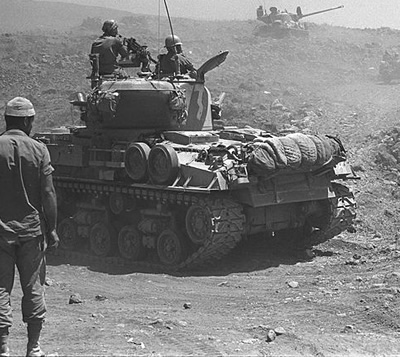The Six Day War, which took place between June 5 and June 10, 1967, was the first Israeli-Arab conflict in which tanks played a major, decisive role.
More than 2,500 tanks were involved.
Israel had Super Sherman, Centurion, Patton and AMX-13 tanks.
During the Six Day War, Israel used a newer, more effective tank strategy. Previously, Israeli tank strategy had revolved around the use of light tanks, such as the AMX-13, for speed and agility. However, during the Six Day War, General Israel Tal decided that the Israelis should focus on using heavier tanks, such as the Centurion and the Patton, which could carry larger weapons and which provided better crew protection.
The Arab countries that opposed Israel in the war, Egypt, Syria, Jordan and Iraq had many T-34/85s.
Egypt also deployed PT-76s, T-54/55s and JS-3s (IS-3s).
Jordan used M48 Pattons. Some of these were captured and later used by the Israelis.
 During the war, the Israelis discovered that while the guns on Patton tanks had a greater range than the guns on Super Shermans, Patton tanks were vulnerable because of their external auxiliary fuel tanks. The Israelis used this knowledge to put many Jordanian M48s out of action.
During the war, the Israelis discovered that while the guns on Patton tanks had a greater range than the guns on Super Shermans, Patton tanks were vulnerable because of their external auxiliary fuel tanks. The Israelis used this knowledge to put many Jordanian M48s out of action.
Background
After the 1956 Suez Crisis, Egypt agreed to allow a UN peacekeeping force to be stationed in the Sinai and to allow Israeli ships to pass through the Strait of Tiran.
In May 1967, Egypt’s president, Gamal Abdel Nasser, forced the peacekeepers to leave the Sinai and closed the Strait of Tiran, preventing ships from reaching Israel via the Gulf of Aqaba. Because of this blockade, Israel could not receive oil from Iran, its main oil supplier. Israel considered this blockade to be an act of war.
Egypt also began building up forces in the Sinai, and Nasser made statements implying that Egypt and other neighboring countries were prepared to fight a war with Israel.
The War
Between June 5 and June 6, 1967, in what it claimed to be a preemptive action, Israel launched a series of major air strikes against the Egyptian, Syrian, Jordanian and Iraqi air forces. 309 Egyptian, 29 Jordanian, 60 Syrian and 17 Iraqi aircraft were destroyed. Most of these aircraft were destroyed before they even get off the ground.
This left Arab ground forces without air cover.
The Israelis lost 26 of their own aircraft in the air attack.
Israel then advanced into the Sinai with a three-pronged ground attack.
General Tal led from the north, with the goal of taking Rajah and then El Arish.
General Ariel Sharon led from the South, aiming to take the Umm Katef plateau and then gain control of a crucial road junction at Abu Agheila.
General Avraham Yoffe’s troops moved between Tal’s and Sharon’s, through sand dunes that previously had been considered impassable. This would allow him get behind enemy defenses and prevent reinforcements from reaching the front at El Arish.
He would then send troops to assist Tal and Sharon.
The Israelis were able to capture Rafah, but with heavy losses. Egyptian JS-3s were able to destroy a number of Israeli M48A2 Pattons.
El Arish was also taken by the Israelis.
Battle of Abu Agheila
On June 5, 1967, General Ariel Sharon and General Avraham Yoffe led Israeli armored forces in a battle against the Egyptians at Abu Agheila.
The Israelis had 150 tanks. Most of these were Centurions and Super Shermans. There were also some AMX-13s.
They faced 66 Egyptian T-34/95s and 22 Egyptian SU-100 tank destroyers. The Egyptian armored fighting vehicles had been obtained from the USSR and Czechoslovakia.
The battle resulted in the deaths of 4,000 Egyptian and 40 Israeli soldiers.
The Egyptians lost 40 AFVs and the Israelis lost 19.
Aftermath
The Six Day War resulted in a clear victory for the Israelis.
By the end of the war, Israel occupied 42,000 (109,000) square miles of additional territory. This included the Sinai Peninsula, the Golan Heights in the north, the West Bank of the Jordan River and Jerusalem’s Old City.
An estimated 600 Arab tanks were destroyed during the Six Day War.
Israel did not lose much armor.
About 750 Israeli soldiers and about 20,000 Arab soldiers were killed.